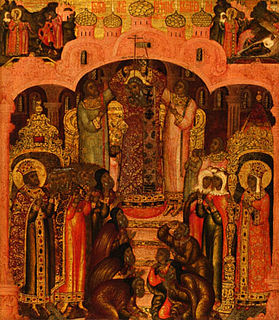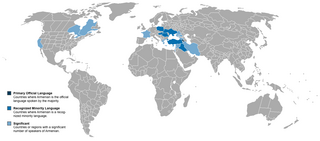Chalcedonian Christianity refers to the Christian denominations adhering to the christological definitions and ecclesiological resolutions of the Council of Chalcedon, the Fourth Ecumenical Council held in 451. Chalcedonian Christians follow the Definition of Chalcedon, a religious doctrine concerning the divine and human natures of Jesus Christ. The great majority of Christian communions and confessions in the 21st century are Chalcedonian, but from the 5th to the 8th centuries the ascendancy of Chalcedonian Christology was not always certain.

Kozan is a city in Adana Province, Turkey, 68 kilometres northeast of Adana, in the northern section of the Çukurova plain. The city is the capital of the ilçe (district) of Kozan. The Kilgen River, a tributary of the Ceyhan, flows through Kozan and crosses the plain south into the Mediterranean. The Taurus Mountains rise up sharply behind the town.

Bogomilism was a Christian neo-Gnostic or dualist sect founded in the First Bulgarian Empire by the priest Bogomil during the reign of Tsar Peter I in the 10th century. It most probably arose in what is today the region of Macedonia as a response to the social stratification that occurred with the introduction of feudalism and as a form of political movement and opposition to the Bulgarian state and the church.

The highest-ranking bishops in Eastern Orthodoxy, Oriental Orthodoxy, the Catholic Church, and the Church of the East are termed patriarchs.

The term exarch comes from the Ancient Greek ἔξαρχος, exarchos, and designates holders of various historical offices, some of them being political or military and others being ecclesiastical.

The Armenian Apostolic Church is the national church of the Armenian people. Part of Oriental Orthodoxy, it is one of the most ancient Christian communities. The Kingdom of Armenia was the first state to adopt Christianity as its official religion under the rule of King Tiridates in the early 4th century. The church originated in the missions of Apostles Bartholomew and Thaddeus in the 1st century, according to tradition.
The Euchites or Messalians were a Christian sect from Mesopotamia that spread to Asia Minor and Thrace. The name 'Messalian' comes from the Syriac ܡܨܠܝܢܐ, mṣallyānā, meaning 'one who prays'. The Greek translation is εὐχίτης, euchitēs, meaning the same.
The Nazarenes originated as a Christian sect of first-century Judaism. The first use of the term "sect of the Nazarenes" is in the Book of Acts in the New Testament, where Paul is accused of being a ringleader of the sect of the Nazarenes. Then, the term simply designated followers of "Yeshua Natzri", as the Hebrew term נוֹצְרִי still does, but in the first to fourth centuries, the term was used for a sect of followers of Jesus who were closer to Judaism than most Christians. They are described by Epiphanius of Salamis and are mentioned later by Jerome and Augustine of Hippo. The writers made a distinction between the Nazarenes of their time and the "Nazarenes" mentioned in Acts 24:5, where Paul the Apostle is accused before Felix at Caesarea by Tertullus.

In the Christian liturgical calendar, there are several different Feasts of the Cross, all of which commemorate the cross used in the crucifixion of Jesus. While Good Friday is dedicated to the Passion of Christ and the Crucifixion, these days celebrate the cross itself, as the instrument of salvation. The most common day of commemoration is September 14 in Roman Catholicism and Eastern Orthodoxy.

Paulicians were a Christian adoptionist sect from Armenia which formed in the 7th century, possibly influenced by Gnostic movement and religion of Marcionism and Manichaeism. According to medieval Byzantine sources, the group's name was derived from the 3rd century Bishop of Antioch, Paul of Samosata, but Paulicianists were often misidentified with Paulianists, while other derived their name from Paul the Apostle, hence the Paul's identity is disputed. It is considered they were formed by Constantine-Silvanus.
Armenian literature begins around AD 400 with the invention of the Armenian alphabet by Mesrop Mashtots.
Grigor Magistros was an Armenian prince, linguist, scholar and public functionary. A layman of the princely Pahlavuni family that claimed descent from the dynasty established by St. Gregory the Illuminator, he was the son of the military commander Vasak Pahlavuni. After the Byzantine Empire annexed the Kingdom of Ani, Gregory went on to serve as the governor (doux) of the province of Edessa. During his tenure he worked actively to suppress the Tondrakians, a breakaway Christian Armenian sect that the Armenian and Byzantine Churches both labeled heretics. He studied both ecclesiastical and secular literature, Syriac as well as Greek. He collected all Armenian manuscripts of scientific or philosophical value that were to be found, including the works of Anania Shirakatsi, and translations from Callimachus, Andronicus of Rhodes and Olympiodorus. He translated several works of Plato — The Laws, the Eulogy of Socrates, Euthyphro, Timaeus and Phaedo. Many ecclesiastics of the period were his pupils.
The Angelici were an obscure heretical sect of the 3rd century.
The Simonians were a Gnostic sect of the 2nd century which regarded Simon Magus as its founder and traced its doctrines, known as Simonianism, back to him. The sect flourished in Syria, in various districts of Asia Minor and at Rome. In the 3rd century remnants of it still existed, which survived until the 4th century.
The Apotactics or Apotactites were adherents of a Christian heresy which sprang up in the third century and spread through the western and southern parts of Asia Minor.

Hovhannavank is a medieval monastery located in the village of Ohanavan in the Aragatsotn Province of Armenia. The monastery stands on the edge of the Kasagh River canyon, and its territory is adjacent to the village of Ohanavan. The deep gorge is carved by the Kasagh River.

Nor Varagavank is a 13th-century Armenian Apostolic Church monastic ensemble situated 3.5 km southwest of the village Varagavan in the Tavush Province of Armenia. The monastery is situated upon a high hill and is surrounded by forested mountains and picturesque ravines.

A conical roof or cone roof is a roof shape, that is circular on plan and rises to terminate in a point, the whole forming a regular cone in shape.

Proto-Protestantism, also called pre-Protestantism, refers to individuals and movements that propagated ideas similar to Protestantism before 1517, when Martin Luther (1483–1546) nailed the Ninety-Five Theses to a church door, which is usually considered the starting year for the Reformation era. Major representatives were Peter Waldo, John Wycliffe (1320s–1384), Jan Hus and the movements they started.














